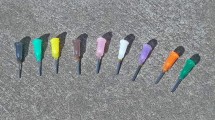Abstract
The science of irrigation scheduling is well advanced, but the field application of this knowledge among irrigators is limited. Case studies are presented to show why irrigators may fail to adopt or persevere with traditional irrigation scheduling methods. This paper describes a funnel-shaped wetting front detector that is buried at an appropriate depth in the root zone. As a wetting front moves into the funnel of the detector, the water content increases due to convergence, so that the water content at the base of the funnel reaches saturation. The free water produced is detected electronically and this provides the signal to stop irrigation. Since the philosophy of drip irrigation in most cases is to supply water little and often, the "when to turn the water on" question becomes redundant and knowing when to turn the water off is more useful. Two further case studies demonstrate the benefits of scheduling micro-irrigation using wetting front detectors. The detectors retain a water sample from each irrigation event and this was used to monitor nitrate movement in and below the root zone.









Similar content being viewed by others
References
Alpkem (1992) The flow solution methodology. Alpkem Corporation, Wilsonville, Ore.
Allen RG, Pereira LS, Raes D, Smith M (1998) Crop evapotranspiration: guidelines for computing crop water requirements. FAO irrigation and drainage paper 56
Australian Academy of Technological Sciences and Engineering (1999) Water and the Australian economy: a joint study project of the Australian Academy of Technological Sciences and Engineering and the Institution of Engineers, Australia. Australian Academy of Technological Sciences and Engineering, Parkville, Victoria, Australia
Chalmers DJ, Mitchell PD, Heek L van (1981) Control of peach tree growth and productivity by regulated water supply, tree density, and summer pruning. J Am Soc Hortic Sci 106:307–312
Charlesworth P (2000) An investigation of sub-surface drip irrigation configurations. PhD dissertation, Charles Sturt University, NSW, Australia
Cresswell HP (1993) Evaluation of the portable pressure transducer technique for measuring field tensiometers. Aust J Soil Res 31:397–406
Dougherty WJ, Wells AT (1998) Nitrate leaching under various vegetable production systems at Somersby. In: Environmental benefits of soil management, National Soils Conference, Brisbane 27–29 April. Australian Soil Science Society
Gardner W, Kirkham D (1952) Determination of soil moisture by neutron scattering. Soil Sci 73:391–401
Greenwood DJ, Cleaver TJ, Turner MK (1974) Fertiliser requirements of vegetable crops. Proc Fert Soc 145:16
Hutchinson PA, Stirzaker RJ (2000) A new method and device for scheduling irrigation. Irrigation Association of Australia, 2000 National Conference, May 23–25, pp 584–592
Jackson RD, Reginato RJ, Idso SB (1977) Wheat canopy temperature: a practical tool for evaluating water requirements. Water Resour Res 13:651–656
Litaor MI (1988) Review of soil solution samplers. Water Resour Res 24:727–733
Loveys B, Stoll M, Dry P, McCarthy M (1998) Partial rootzone drying stimulates stress responses in grapevine to improve water use efficiency while maintaining crop yield and quality. Australian Grapegrower and Winemaker, Technical issue, 414:108–114
Meyer WS, Nobel CL (1993) Assessing the impact of irrigation on resources: irrigation management to meet environmental constraints. In: Irrigation Association of Australia Proceedings, Launceston, Tasmania, Australia, p17
Paramasivam S, Alva AK, Fares A (1997) Vadose zone soil solution sampling techniques to investigate pollutant transport in soils. Trends Soil Sci 2:115–136
Philip JR (1969) Theory of infiltration. Adv Hydrosci 5:215–296
Richards LA, Neal OR (1936) Some field observations with tensiometers. Soil Sci Soc Am Proc 1:71
Rudich J, Kalmar D, Geizenberg C, Harel S (1977) Low water tensions in defined growth stages of processing tomato plants and their effects on yield and quality. J Hortic Sci 52:391–399
Schmitz M, Sourell H (2000) Variability in soil moisture measurements. Irrig Sci 19:147–151
Stirzaker RJ, Hutchinson PA (1997) Moisture detection. Australian Petty Patent 681994, granted 11 September 1997
Stirzaker RJ (1999) The problem of irrigated horticulture: matching the biophysical efficiency with the economic efficiency. Agrofor Syst 45:187–202
Stirzaker RJ, Mosena ML, Etherington RJ (1996) Soil and irrigation management for small-scale commercial vegetable farmers in the Northern Province of South Africa. Centre for Environmental Mechanics technical report no 112
Stirzaker RJ, Hutchinson PA, Mosena ML (2000) A new way for small farm irrigators to save water. In: Proceedings of the sixth International micro-irrigation congress, 23–26 October 2000, Cape Town. South African National Association of Irrigation and Drainage, Cape Town, pp 4.3 1–10
White I, Zegelin SJ (1995) Electric and dielectric methods for monitoring soil-water content. In: Wilson LG, Everett LG, Cullen SJ (eds) Handbook of vadose zone characterization and monitoring. Lewis, London, pp 343–385
Zegelin, SJ, White I, Jenkins DR (1989) Improved field probes for soil-water content and electrical conductivity measurement using time domain reflectometry. Water Resour Res 25:2367–2376
Zur B, Ben-Hanan U, Rimmer A, Yardeni A (1994) Control of irrigation amounts using the velocity and position of wetting front. Irrig Sci 14:207–212
Acknowledgements
I thank a number of collaborators who took part in one or more of the case studies, including Paul Hutchinson, Chris Drury, Lazarus Mosena, Tony Wells, Phil Charlesworth, Jo Alison and Alison Jones. Aspects of the work were funded by AusAID, Land and Water Australia, and the Rural Research and Development Corporation.
Author information
Authors and Affiliations
Corresponding author
Additional information
Communicated by P. Thorburn
Rights and permissions
About this article
Cite this article
Stirzaker, R.J. When to turn the water off: scheduling micro-irrigation with a wetting front detector. Irrig Sci 22, 177–185 (2003). https://doi.org/10.1007/s00271-003-0083-5
Received:
Accepted:
Published:
Issue Date:
DOI: https://doi.org/10.1007/s00271-003-0083-5




